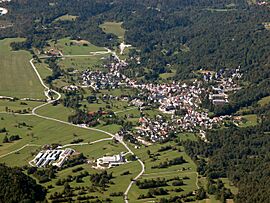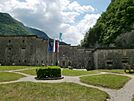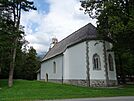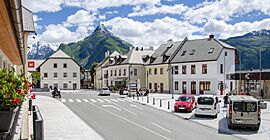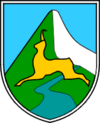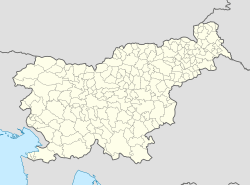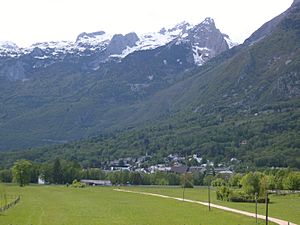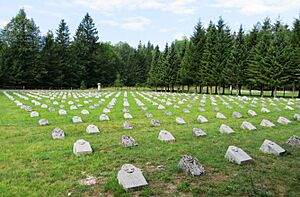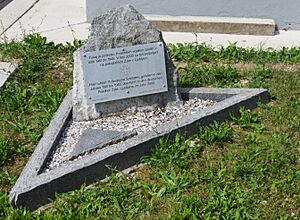Bovec facts for kids
Quick facts for kids
Bovec
|
|||
|---|---|---|---|
|
Town
|
|||
|
From top, left to right: Bovec from above, Administration building, Kluže Fort, St. Mary's Church, Martinov Hram Inn, Town center
|
|||
|
|||
| Country | |||
| Traditional region | Slovene Littoral | ||
| Statistical region | Gorizia | ||
| Municipality | Bovec | ||
| Area | |||
| • Total | 25.22 km2 (9.74 sq mi) | ||
| Elevation | 453.5 m (1,487.9 ft) | ||
| Population
(2020)
|
|||
| • Total | 1,586 | ||
| • Density | 62.89/km2 (162.88/sq mi) | ||
| Climate | Cfb | ||
Bovec is a charming town in northwestern Slovenia. It's located in the beautiful Littoral region, very close to the border with Italy. Bovec is the main town in its area, known as the Municipality of Bovec.
Contents
Geography of Bovec
Bovec is about 136 kilometers (84 miles) away from Slovenia's capital city, Ljubljana. It sits at a height of about 434 meters (1,424 feet) above sea level. The town is nestled in a basin near the top of the Soča River.
It's also at the foot of Mount Kanin, which is part of the Julian Alps mountains. This mountain range forms the border with Italy. Nearby, the Trenta Valley leads into the amazing Triglav National Park. Historically, Bovec was part of the Goriška region. But today, people there feel more connected to the larger Slovene Littoral region.
History of Bovec
People have lived in the upper Soča Valley since ancient times, even as far back as the Hallstatt culture era. In Roman times, this area was part of the Roman road leading to the Predil Pass. It was part of the Roman province of Italia.
Later, in 774, it became part of the Carolingian Empire after Charlemagne conquered the Italian Kingdom. In 952, it came under the rule of Otto I of Germany. Bovec was first mentioned in 1192. At that time, it belonged to the church-ruled Patria del Friuli. It was part of Tolmin County, which was taken over by the Republic of Venice in 1420.
Habsburg Rule and Changes
The lands around the upper Soča River became part of the Inner Austrian lands in 1509. This happened under Emperor Maximilian I during the War of the League of Cambrai. It was added to the County of Gorizia. In 1754, it became the Princely County of Gorizia and Gradisca.
Most of this area, where people spoke Slovene, stayed under Austrian rule until 1918. There was a short break between 1809 and 1813 when it was divided between the Napoleonic Kingdom of Italy and Illyrian Provinces. From 1815, it was part of the Kingdom of Illyria. Then, from 1849, it was part of the Austrian Littoral. In the 1800s, Slovene completely replaced German as the main language.
From 1868, during the Austro-Hungarian period, Bovec was managed as part of the Tolmein district. The Austro-Hungarian Army built two forts along the Predil Pass road. These were the well-preserved Kluže Fortress (built in 1881–82) and the ruined Fort Hermann.
World War I and Its Impact
During World War I, the area around Bovec saw very intense fighting. These were the Battles of the Isonzo, which took place between Austro-Hungarian and Italian armies from June 1915 to November 1917. The battles caused a lot of damage to the region.
After the war, a military cemetery east of Bovec was made bigger. The remains of soldiers from both sides were moved there. Later, in 1938, the Italian soldiers' remains were moved to an Italian military memorial outside Kobarid. Over 600 soldiers are buried in the Bovec cemetery.
After the Battle of Vittorio Veneto in 1918, Italian forces took over Bovec. In 1920, the Treaty of Rapallo officially made it part of Italy. During the Italian Fascist rule from 1922 to 1943, Slovene-speaking people were forced to adopt Italian ways. Many locals joined the secret anti-fascist group called TIGR. Others moved to the nearby Kingdom of Yugoslavia.
World War II and After
Between 1943 and 1945, Nazi German forces occupied the area. Slovene partisans (resistance fighters) were active here. After the Yugoslav People's Army freed the area in May 1945, Bovec was under joint British-U.S. control. From June 1945 to September 1947, Bovec was in Zone A of the former Julian March. This zone was under Allied military rule. The border with the Yugoslav zone was just a few kilometers east of the town.
Mass Grave Memorial
Bovec has a special memorial related to Second World War. It's called the Cemetery Mass Grave. It is located near the entrance to the town cemetery. This grave held the remains of 11 German soldiers who died between 1941 and 1945. Their names are all known. In 2000, the remains were moved to Žale Cemetery in Ljubljana. This grave was well cared for, even during the communist era. A plaque in Slovene and German marks the spot.
In September 1947, the Paris Peace Treaties gave Bovec to Yugoslavia. In 1951, Bovec officially became a town. When Yugoslavia broke up in 1991, Bovec became part of independent Slovenia.
Bovec was badly damaged by an earthquake in 1976. Another strong earthquake hit the town in April 1998. A weaker one happened in July 2004.
Economy and Tourism
Many people in Bovec work in tourism. The area has become very popular with visitors, filmmakers, and advertisers. Part of the Disney movie The Chronicles of Narnia: Prince Caspian was filmed here. In 2008, the area won an award called the European Destinations of Excellence for its Soča Stories project.
There are many exciting places to visit around Bovec. These include Boka Falls, Triglav Mountain (2864 m), the Soča River, Lake Krn, and the Kanin (Sella Nevea) ski resort. You can also visit the Vršič Pass (1611 m) and the mountain road to the Mangart Saddle.
Fun activities in Bovec include kayaking, rafting, and hiking. You can hike the Peace Trail to Kluže Fortress or explore the Soča Trail and the Alpe-Adria Trail. There are also cheese tastings, a circular cableway on Kanin, and a zip line. You can also go fishing.
Famous People from Bovec
Here are some notable people who were born or lived in Bovec:
- Vasja Klavora (born 1936), an author and politician.
See also
 In Spanish: Bovec para niños
In Spanish: Bovec para niños


